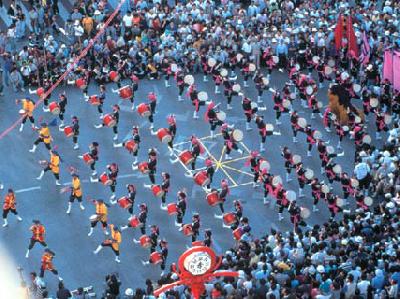Wa-daiko are percussion instruments and a general term used for Japanese stick drums.
They are made from the trunk of a tree such as Keyaki wood which is hollowed out and sealed on both ends of the drum body with animal skin, mostly from cows. The player beats the skin and it vibrates to make sound.
There is another traditional percussion instrument called tsuzumi which has the same construction as wa-taiko but a smaller size. Tzuzumi are played with the hand, as opposed to the taiko drum which is struck with a drumstick or other instrument.
The history of the taiko drum goes back to ancient times - as early as the Joumon period (BC10,000 – BC300) in which a musical instrument with a similar structure is said to have already existed.
In the Middle Ages, when Dengaku - dance performance to celebrate the harvest, was developed, Ohayushi-daiko, smaller stick drums, became popular. In the Sengoku period, taiko drums were used for military purposes (Jin-daiko) and, in the Edo period, they were used inside the Edo Castle to announce the time. Over the ages, taiko drums were used for many occasions and purposes and they have become rooted in people’s everyday life.
The fact that taiko drums have been used as ceremonial tools to communicate with God in temples and shrines has made them very special instruments that resonate deeply in the Japanese people’s hearts.
In the Showa period, contemporary ensemble style drumming called Kumi-daiko became popular. It is made up of various different kinds of taiko drums, and the unique sound has been enchanting people around the world ever since.



















